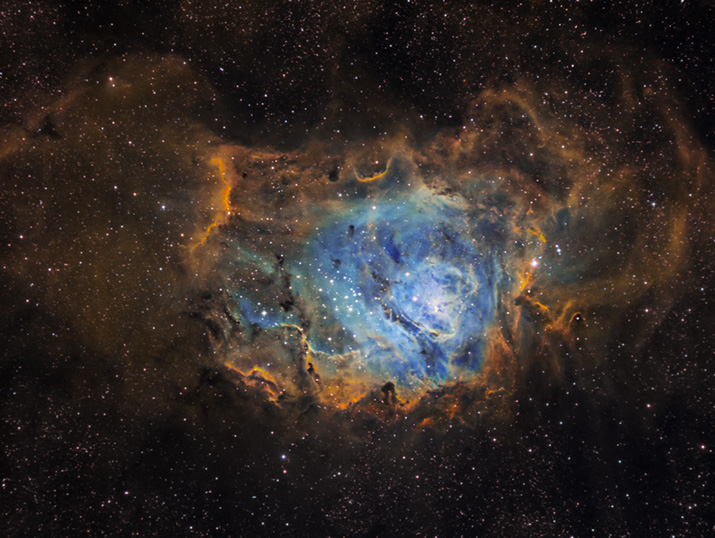
|
Date: June 12 13 14, 2018 - Location: Davis Mountains west of Fort Davis, Texas Telescope: Stellarvue SV102ED - Camera: ST-8300M - Mount: MI-250 Exposure: SII = 300 min. HA = 280 min. OIII= 300 min. Click on the image to view at higher resolution. |

|
Messier 8 (M8) is commonly known as the Lagoon Nebula. The nebula is bright for a "deep sky" object and is visible under very dark skies. With this in mine, it must have been observed in antiquity. It, however, was first historically noted by Sicilian astronomer Giovanni Battista Hodierna in 1654. M8 is located in the constellation Sagittarius and lies approximately 5,200 light-years from the Earth. The nebula is a very large "stellar nursery" and covers an area approximately 50 light-years across. Images obtained with the Hubble Space Telescope reveal active stellar birth and accompanying Herbig-Haro objects in the central portion of the nebula. Numerous dark clouds, known as "Bok Globules", are scattered through the Lagoon. These clouds are made of condensing gas and dust and are well on the way of forming new "protostars" and ultimately fully formed stars. Located within and to the left side of the bright "blue" portion of the image is the open cluster NGC 6530. The stars in the cluster are only a few million years old and are the product of the star forming activities of the Lagoon Nebula that continue to today. The image above was assembled from data taken through narrowband filters to produce a false color, narrowband, image. Sulfur II is mapped to Red, Hydrogen Alpha is mapped to Green, and Oxygen III is mapped to Blue. (Hubble Standard Palette) The Stars were overlaid with data from a near true color Ha, OIII, OIII mapped image. 1http://messier.seds.org/m/m008.html
|